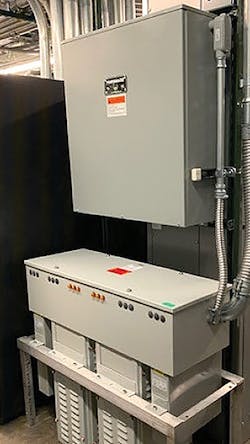To Protect Vulnerable Assets, Optimize Power Quality
Many metalcasters would be “shocked” at the variable (perhaps even poor) quality of the electricity being delivered from the grid. One could reasonably assume that since the lights come on – and usually stay steady – that the flow of electricity is nice and steady. But your computers, PLC’s, melting furnaces and other equipment might have a very different perspective.
Electron tempest
Without sophisticated monitoring equipment, you’d probably never know of the variety of quality issues that may be present in your electric supply. Voltage sags and swells, transients, harmonic distortion, and other things often are unnoticed but can play havoc with your sensitive electronics. Motors can run hotter than normal and power consumption can rise. Serious quality issues can cause equipment to fail and need to be replaced, impacting production, throughput, and revenue.
Your electric utility doesn’t watch for power-quality issues inside your foundry. It’s up to you to guard against such problems and protect your sensitive equipment. Later in this article we review a product that can help protect your foundry assets from these issues.
Most utilities will monitor how you use the power they supply, because that can affect their operations and costs. They calculate a Power Factor (PF) indicating how efficiently you consume that power: It’s represented as a percentage, with greater inefficiencies indicated as lower-percentage PFs. Foundries using large electric motors and induction furnaces often have less efficient PF values.Low Power Factors can negatively impact electric utility operations costs by causing more power transmission losses; increased power generation resources; higher power distribution costs; greater maximum demand; and lower overall system efficiency
To incentivize companies to use power more efficiently, many utilities charge penalties for a PF that is too low. You may see those penalties as line items on your utility bill, but they also may be a part of more obscure billing details. Such charges can be significant.
Each utility determines the threshold for “efficient” PF levels, but they often use between 85% and 95% (kW/kVA). If your PF level is bad enough, the supplier may insist that special PF Correction Capacitors be installed (on the utility side of the return circuit) to fix the problem. This is to protect the utility’s infrastructure, capital and profits, not the foundry’s.
What can you do?
Even if you don’t have power-quality issues, you are constantly exposed to them. As the electric grid becomes less stable such issues are likely to intensify, so how can metalcasters protect their assets?
Having specialists monitor and analyze the quality of the electricity being supplied is a good start. It will provide a baseline for understanding the potential scope of the problem and verifying the potential impact. It also can be used to identify solutions to isolate / minimize the existing issues.
One power-quality monitoring solution (pictured) can:
• Eliminate sags, blips, spikes, and surges;
• Balance three-phase voltages
• Boost system voltage;
• Reduce harmonic distortion;
• Reduce KW and KVA demand;
• Reduce KWH consumption;
• Reduce amperage; and
• Improve power factor.
Recently we prepared a proposal for this system for a mid-sized foundry, including purchase, installation and maintenance costs, to provide positive cash-flow savings every year of the seven-year agreement. The foundry would own the equipment at the end of the agreement, and greater savings would be realized for the balance of the anticipated 25-year service life of the equipment.
This equipment is installed at the electric distribution panel, protecting all the foundry equipment connected to it, sort of like a surge protector on steroids.
Off balance sheet
One option for this solution is an energy-as-a-service company that will purchase, install, and maintain it. A great benefit of this approach is that the savings generated by the device are used to pay for it over the term of the agreement, and it can be accounted as an off-balance-sheet item, saving a capital expense. You pay nothing out-of-pocket and get full benefits from the day it is installed. At the end of the agreement, you own the equipment. Of course, you also can commit capital for a direct purchase, if desired.
There are numerous case studies from over 1,500 installations, available on request, documenting improved voltage, lower kW demand, increased Power Factor, and fewer amps required. All these manufacturers also experienced a reduction in kWh, cooler running motors, and a virtual elimination of electric sags and spikes. How much you can benefit depends on your specific electric service and usage. We provide a free assessment of your potential savings by reviewing your electric usage data and electric cost structure.
Brian Reinke, president of TDI Consulting, is an energy-cost saving consultant. Contact him at [email protected] for a customized, no-obligation quote to review your electric system.
About the Author
Brian Reinke
President
Brian Reinke, president of TDI Energy Solutions, is an energy-cost saving consultant. Contact him at 630-343-0971.

